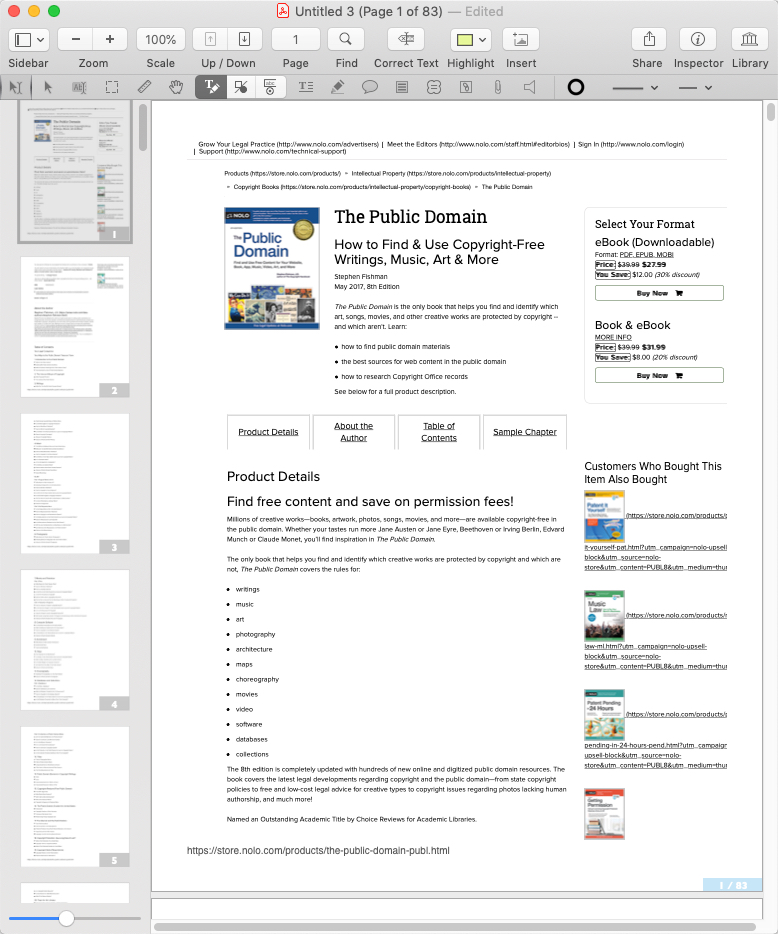PDFpenPro 12 for Mac (https://smilesoftware.com/pdfpenpro/) is the best-in-class solution for viewing, editing, modifying, and distributing documents composed in the PDF file format.
The notion of developing a robust method of viewing complex documents across computer platforms was first expressed by John Warnock, the co-founder and former president of Adobe Systems, Inc. The technology that he described in the early 1990s was code-named “Carousel,” and consisted of a procedure for converting PostScript files into a uniform format that could be viewed on a Windows, Macintosh, or Unix computer, regardless of its origin. The objective of such a technology was to simplify the process of sharing documents electronically, with full visual fidelity, and without the need for the recipient to possess the application or fonts that were used to create it. That goal was met with the release of Adobe Acrobat in 1993, and it’s renown and ubiquitous file format, PDF.
The format’s most compelling feature, as its name implies, is its portability. Any PDF file can be viewed, navigated, and printed by using a free PDF reader (https://get.adobe.com/reader/). Readers are available for Macintosh, Windows, and Unix computers, as well as iOS (from the iTunes App Store) and Android devices (from Google Play). Mac users can also process PDFs in Preview with limited options including viewing, annotation, password protection, file conversion, form-filling, and the combination of two or more PDFs.

PDFpenPro 12 enables a user to go far beyond the limited set of capabilities provided by the free Acrobat readers and Mac Preview. The readers are free since a PDF document would have no value at all if it couldn’t be viewed and printed. With PDFpenPro 12 a user can fill in forms, sign contracts and other legal documents (using the mouse or a scanned signature), add or block-out text, make corrections and additions, number lines, add watermarks, and more. Pages can be viewed in a variety of ways, including facing, multi-page, multiple facing pages, as well as single page. Pages can be moved, re-ordered, and deleted easily, both within a single PDF, and between two or more PDFs. PDF forms can be created, filled in, saved, and transmitted. Forms can be written on to add signatures or other data, and can accept image files. Users can also reorder pages, merge multiple PDFs, delete pages, and even create their own fillable PDF forms, bookmarks, and tables of contents. Legally recognized personal signatures can be entered using DocuSign® support.
The program can process a website into an off-line searchable PDF with active hyperlinks. The resultant PDF can be marked-up for highlighting pertinent information, or for assessing the quality and utility of a website in development.

The data collection feature provides the capability to convert a scanned document into a PDF form that can be distributed to Macintosh, Windows, and iOS/Android users. The program enables the user to add text fields, checkboxes, and radio buttons for surveys, questionnaires, polls, contracts, applications, etc.
As an image editor it can copy, delete, move, resize, and physically adjust (resolution, color depth, contrast) images. The features are extensive, and range from direct scanning and OCR of paper documents (using the OmniPage version 20.2 OCR engine); using Image Capture or TWAIN scanners; to the reordering of PDF pages, and appending multiple PDF documents. The size of a PDF document can be optimized for distribution using user-defined image quality settings and the elimination of third party metadata.


Users can listen to the text in a PDF by using the Speech option; and can add Audio Annotations for playback by the PDF recipient. Viewing of a PDF’s content is facilitated by a Magnifier window that supports viewing of a selected area at up to 2000%.


PDFpen for iPad and iPhone brings highly useful PDF editing and annotating capabilities to the mobile platform. This iOS version enables the user to view and edit their PDFs on their iOS device, store them on iCloud (or Dropbox, Evernote, Bublup, or Google Docs), and do further review and edits on their Mac version of PDFpenPro as necessary.
With their iOS device in hand, the user can now fill in forms, such as applications, contracts, and surveys, sign them, and return them by e-mail. PDFs can be edited, with changes to text and images, and annotated (with notes, comments, freehand scribbles, lines, arrows, rectangles, ellipses, polygons, highlighting, underscoring, call-outs, and proofreading marks) for collaboration with others.
PDFpenPro is essential for digital publishing workflows, enabling users to examine, edit, and approve work-in-process no matter where they are.
Supported import file formats are PDF, TIFF, JPEG, PNG, DOC, and DOCX. Supported output file formats are PDF, TIFF, JPEG, PNG, DOCX, TXT, RTF, XLSX, PPTX, and PDF/A-1b.
Complete documentation is provided, composed of an on-line manual in both HTML and PDF, an FAQ, a Knowledge Base, video tutorials, a blog, in-product help, a Welcome to PDFpenPro opening window, and a free copy of Michael E. Cohen’s “Take Control of PDFpen.”

PDFpenPro $129.95, $159.95 for the Family Pack, and a starting price of $374.95 for the Office Pack. The prices for the entry-level PDFpen are $79.95, $99.95 for the Family Pack, and a starting price for the Office Pack of $249.95. A free trial version is available at https://smilesoftware.com/pdfpenpro/.
Contact: SmileOnMyMac, LLC, PMB 278, 350 Bay Street, Suite 100, San Francisco, CA 94133, http://www.smilesoftware.com, e-mail: info@smilesoftware.com.
